Role of Glycans in Equine Endometrial Cell Uptake of Extracellular Vesicles Derived from Amniotic Mesenchymal Stromal Cells
Abstract
:1. Introduction
2. Results
2.1. Evaluation of eAMC-EV Incorporation into eECs
2.2. Characterization of AMC-EV Glycans with a Panel of FITC-Labeled Lectins
2.3. Detection of N-Linked, Fucosylated, and Sialylated Glycans on eEC Surface with FITC-Labelled Lectins
2.4. Effect of De-Fucosylation and De-Sialylation on eEC Uptake by eAMC-EVs
2.5. Evaluation of eAMC-EV Incorporation into eECs After Masking of Carbohydrate Residues with Unconjugated Lectins
3. Discussion
4. Materials and Methods
4.1. Materials
4.2. Experimental Design
4.2.1. Preliminary Phase
Epithelial Endometrial Cell Isolation (eECs) and Culture
Equine Amniotic Membrane Collection and Amniotic Mesenchymal Stromal Cell (eAMC) Isolation
Equine Amniotic Mesenchymal Stromal Cell (eAMC) Expansion and Conditioned Medium Production
Isolation of Extracellular Vesicles (EVs) and Their Labelling
4.2.2. Evaluation of eAMC-EV Incorporation into eECs
4.2.3. Characterization of AMC-EV Glycans with a Panel of FITC-Labeled Lectins
4.2.4. Detection of N-Linked, Fucosylated, and Sialylated Glycans on eEC Surface with FITC-Labelled Lectins
4.2.5. Effect of De-Fucosylation and De-Sialylation on eEC Uptake by eAMC-EVs
4.2.6. Evaluation of eAMC-EV Incorporation into eECs After Masking of Carbohydrate Residues with Unconjugated Lectins
- Step 1: PKH-26 labeled EVs were incubated in suspension with each of the unconjugated lectins overnight at room temperature. The following day, eAMC-EVs were ultracentrifuged to remove the excess of unbound lectins, and the total volume was brought to 1 mL with a serum-free DMEM base medium.
- Step 2: forty-eight hours before the co-incubation experiment, eECs at P1 were thawed and seeded on 24 × 24 coverslips placed in 9 wells of six-well plates (one for each lectin used). Cells were cultured with complete DMEM.
- Step 3: labeled eAMC-EVs bound to the 9 unconjugated lectins were added to eECs (one lectin per well).
4.3. Statistical Analysis
5. Conclusions
Author Contributions
Funding
Institutional Review Board Statement
Informed Consent Statement
Data Availability Statement
Acknowledgments
Conflicts of Interest
Abbreviations
| AAL | Aleuria aurantia |
| Con A | Canavalia ensiformis |
| eAMC-EVs | Equine amniotic mesenchymal stromal/stem cell-derived EVs |
| eAMCs | Equine amniotic mesenchymal stromal cells |
| eECs | Equine endometrial epithelial cells |
| EVs | Extracellular vesicles |
| FBS | Fetal bovine serum |
| HG-DMEM | High-glucose Dulbecco’s modified Eagle’s medium |
| LTA | Lotus tetragonolobus |
| MAL II | Maackia amurensis |
| PBS | Phosphate buffer solution |
| PNA | Arachis hypogaea |
| RCA120 | Ricinus communis |
| RT | Room temperature |
| SBA | Glycine max |
| SNA | Sambucus nigra |
| UEA I | Ulex europaeus I |
References
- Arévalo-Turrubiarte, M.; Baratta, M.; Ponti, G.; Chiaradia, E.; Martignani, E. Extracellular vesicles from equine mesenchymal stem cells decrease inflammation markers in chondrocytes in vitro. Equine Vet. J. 2022, 54, 1133–1143. [Google Scholar] [CrossRef]
- Soukup, R.; Gerner, I.; Gültekin, S.; Baik, H.; Oesterreicher, J.; Grillari, J.; Jenner, F. Characterisation of extracellular vesicles from equine mesenchymal stem cells. Int. J. Mol. Sci. 2022, 23, 5858. [Google Scholar] [CrossRef]
- Lange Consiglio, A.; Perrini, C.; Tasquier, R.; Deregibus, M.C.; Camussi, G.; Pascucci, L.; Marini, M.G.; Corradetti, B.; Bizzaro, D.; De Vita, B.; et al. Microvesicles secreted from equine amniotic-derived cells and their potential role in reducing inflammation in a tendon in vitro model. Stem Cells Dev. 2016, 25, 610–621. [Google Scholar] [CrossRef] [PubMed]
- Perrini, C.; Strillacci, M.G.; Bagnato, A.; Esposti, P.; Marini, M.G.; Corradetti, B.; Bizzarro, D.; Idda, A.; Ledda, S.; Capra, E.; et al. Microvesicles secreted from equine amniotic-derived cells and their potential role in reducing inflammation in endometrial cells in an in-vitro model. Stem Cell Res. Ther. 2016, 7, 169. [Google Scholar] [CrossRef] [PubMed]
- Lange-Consiglio, A.; Funghi, F.; Cantile, C.; Idda, A.; Cremonesi, F.; Riccaboni, P. Case Report: Use of amniotic microvesicles for regenerative medicine treatment of a mare with chronic endometritis. Front. Vet. Sci. 2020, 7, 347. [Google Scholar] [CrossRef]
- Varki, A.; Gagneux, P. Biological functions of glycans. In Essentials of Glycobiology, 3rd ed.; Varki, A., Ed.; Cold Spring Harbor Laboratory Press: New York, NY, USA, 2017; pp. 77–88. [Google Scholar] [CrossRef]
- Walker, S.A.; Aguilar Diaz De Leon, J.S.; Busatto, S.; Wurtz, G.; Zubair, A.C.; Borges, C.R.; Wolfram, J. Glycan node analysis of plasma-derived extracellular vesicles. Cells 2020, 9, 1946. [Google Scholar] [CrossRef] [PubMed]
- Macedo-da-Silva, J.; Santiago, V.F.; Rosa-Fernandes, L.; Marinho, C.R.F.; Palmisano, G. Protein glycosylation in extracellular vesicles: Structural characterization and biological functions. Mol. Immunol. 2021, 135, 226–246. [Google Scholar] [CrossRef] [PubMed]
- Islam, K.; Khan, M.; Gidwani, K.; Witwer, K.W.; Lamminmaki, U.; Leivo, J. Lectins as potential tools for cancer biomarker discovery from extracellular vesicles. Biomark. Res. 2023, 11, 85. [Google Scholar] [CrossRef] [PubMed]
- Williams, C.; Royo, F.; Aizpurua-Olaizola, O.; Pazos, R.; Boons, G.J.; Reichardt, N.-C.; Falcon-Perez, J.M. Glycosylation of extracellular vesicles: Current knowledge, tools and clinical perspectives. J. Extracell. Vesicles 2018, 7, 1442985. [Google Scholar] [CrossRef]
- Williams, C.; Pazos, R.; Royo, F.; González, E.; Meritxell, R.-F.; Aitor, M.; Gamiz, J.; Christian, N.; Reichardt, N.-C.; Falcón-Pérez, J.M. Assessing the role of surface glycans of extracellular vesicles on cellular uptake. Sci. Rep. 2019, 9, 11920. [Google Scholar] [CrossRef]
- Li, B.; Hao, K.; Ma, C.; Li, Z.; Li, H.; Du, W.; Sun, L.; Jia, T.; Liu, A.; Li, Y.; et al. Isolation and characterization of fucosylated extracellular vesicles based on a novel high-throughput GlyExo-Capture technique. BioRxiv 2021. [Google Scholar] [CrossRef]
- Zheng, W.; He, R.; Liang, X.; Roudi, S.; Bost, J.; Coly, P.-M.; van Guillaume, N.; Andaloussi, S.E.L. Cell-specific targeting of extracellular vesicles though engineering the glycocalyx. J. Extracell. Vesicles 2022, 11, 12290. [Google Scholar] [CrossRef] [PubMed]
- Shimoda, A.; Miura, R.; Tateno, H.; Seo, N.; Shiku, H.; Sawada, S.I.; Sasaki, Y.; Akiyoshi, K. Assessment of surface glycan diversity on extracellular vesicles by lectin microarray and glycoengineering strategies for drug delivery applications. Small Methods 2022, 6, 2100785. [Google Scholar] [CrossRef] [PubMed]
- Shimoda, A.; Tahara, Y.; Sawada, S.-I.; Sasaki, Y.; Akiyoshi, K. Glycan profiling analysis using evanescent-field fluorescence assisted lectin array: Importance of sugar recognition for cellular uptake of exosomes from mesenchymal stem cells. Biochem. Biophys. Res. Commun. 2017, 491, 701–707. [Google Scholar] [CrossRef] [PubMed]
- Royo, F.; Cossío, U.; Ruiz De Angulo, A.; Llop, J.; Falcon-Perez, J.M. Modification of the glycosylation of extracellular vesicles alters their biodistribution in mice. Nanoscale 2019, 11, 1531–1537. [Google Scholar] [CrossRef] [PubMed]
- Sharon, N.; Lis, H. History of lectins: From hemagglutinins to biological recognition molecules. Glycobiology 2004, 14, 53R–62R. [Google Scholar] [CrossRef] [PubMed]
- Brooks, S.A. Lectins as versatile tools to explore cellular glycosylation. Eur. J. Histochem. 2024, 68, 3959. [Google Scholar] [CrossRef] [PubMed]
- Krishnamoorthy, L.; Bess Jr, J.W.; Preston, A.B.; Nagashima, K.; Mahal, L.K. HIV-1 and microvesicles from T cells share a common glycome, arguing for a common origin. Nat. Chem. Biol. 2009, 5, 244–250. [Google Scholar] [CrossRef] [PubMed]
- Batista, B.S.; Eng, W.S.; Pilobello, K.T.; Hendricks-Munoz, K.D.; Mahal, L.K. Identification of a conserved glycan signature for microvesicles. J. Proteome Res. 2011, 10, 4624–4633. [Google Scholar] [CrossRef] [PubMed]
- Desantis, S.; Accogli, G.; Albrizio, M.; Rossi, R.; Cremonesi, F.; Lange-Consiglio, A. Glycan Profiling Analysis of equine amniotic progenitor mesenchymal cells and their derived extracellular microvesicles. Stem Cells Dev. 2019, 28, 812–821. [Google Scholar] [CrossRef]
- Slivka, E.V.; Shilova, N.V.; Obraztsova, E.A.; Kapustkina, D.S.; Khaidukov, S.V.; Nokel, A.Y.; Ryzhov, I.M.; Henry, S.M.; Bovin, N.V.; Rapoport, E.M. Surface glycans of microvesicles derived from endothelial cells, as probed using plant lectins. Int. J. Mol. Sci. 2024, 25, 5725. [Google Scholar] [CrossRef] [PubMed]
- Lange-Consiglio, A.; Gaspari, G.; Funghi, F.; Capra, E.; Cretich, M.; Frigerio, R.; Bosi, G.; Cremonesi, F. Amniotic mesenchymal-derived extracellular vesicles and their role in the prevention of persistent post-breeding induced endometritis. Int. J. Mol. Sci. 2023, 24, 5166. [Google Scholar] [CrossRef] [PubMed]
- Théry, C.; Witwer, K.W.; Aikawa, E.; Alcaraz, M.J.; Anderson, J.D.; Andriantsitohaina, R.; Antoniou, A.; Arab, T.; Archer, F.; Atkin-Smith, G.K.; et al. Minimal information for studies of extracellular vesicles 2018 (MISEV2018): A position statement of the international society for extracellular vesicles and update of the MISEV2014 Guidelines. J. Extracell. Vesicles 2018, 7, 1535750. [Google Scholar] [CrossRef]
- Lange Consiglio, A.; Lazzari, B.; Perrini, C.; Pizzi, F.; Stella, A.; Cremonesi, F.; Capra, E. MicroRNAs of equine amniotic mesenchymal cells-derived microvesicles and their involvement in anti-inflammatory process. Cell Transplant. 2018, 27, 45–54. [Google Scholar] [CrossRef] [PubMed]
- Lis, H.; Sharon, N. Lectins: Their chemistry and application to immunology. In The Antigens; Academic Press: Cambridge, MA, USA, 1977; Volume IV, pp. 429–529. [Google Scholar] [CrossRef]
- Goldstein, I.J.; Hayes, C.E. The Lectins: Carbohydrate-binding proteins of plants and animals. Adv. Carbohydr. Chem. Biochem. 1978, 35, 127–340. [Google Scholar] [CrossRef]
- Kennedy, J.F.; Palva, P.M.G.; Corella, M.T.S.; Cavalcanti, M.S.M.; Coelho, L.C.B.B. Lectins, versatile proteins of recognition: A review. Carbohydr. Polym. 1995, 26, 219–230. [Google Scholar] [CrossRef]
- Bojar, D.; Meche, L.; Meng, G.; Eng, W.; Smith, D.; Cummings, R.D.; Mahal, L.K. A Useful guide to lectin binding: Machine-learning directed annotation of 57 unique lectin specificities. ACS Chem. Biol. 2022, 17, 2993–3012. [Google Scholar] [CrossRef] [PubMed]
- Escrevente, C.; Keller, S.; Altevogt, P.; Costa, J. Interaction and uptake of exosomes by ovarian cancer cells. BMC Cancer 2011, 11, 108. [Google Scholar] [CrossRef]
- Terävä, J.; Verhassel, A.; Botti, O.; Islam, M.K.; Leivo, J.; Wittfooth, S.; Härkönen, P.; Pettersson, K.; Gidwani, K. Primary breast cancer biomarkers based on glycosylation and extracellular vesicles detected from human serum. Cancer Rep. 2021, 5, 1540. [Google Scholar] [CrossRef]
- Schwarz, F.; Aebi, M. Mechanisms and principles of N-linked protein glycosylation. Curr. Opin. Struct. Biol. 2011, 21, 576–582. [Google Scholar] [CrossRef] [PubMed]
- Mathivanan, S.; Simpson, R.J. ExoCarta: A compendium of exosomal proteins and RNA. Proteomics 2009, 9, 4997–5000. [Google Scholar] [CrossRef] [PubMed]
- Paolini, L.; Orizio, F.; Busatto, S.; Radeghieri, A.; Bresciani, R.; Bergese, P.; Monti, E. Exosomes secreted by Hela cells shuttle on their surface the plasma membrane-associated sialidase NEU3. Biochemistry 2017, 56, 6401–6408. [Google Scholar] [CrossRef] [PubMed]
- Varki, A.; Schnaar, R.L.; Schauer, R. Sialic acids and other nonulosonic acids. In Essentials of Glycobiology, 3rd ed.; Varki, A., Ed.; Cold Spring Harbor Laboratory Press: New York, NY, USA, 2017; pp. 179–195. [Google Scholar]
- Hamouda, H.; Ullah, M.; Berger, M.; Sittinger, M.; Tauber, R.; Ringe, J.; Blanchard, V. N-glycosylation profile of undifferentiated and adipogenically differentiated human bone marrow mesenchymal stem cells: Towards a next generation of stem cell markers. Stem Cells Dev. 2013, 2, 3100–3113. [Google Scholar] [CrossRef] [PubMed]
- Lange-Consiglio, A.; Accogli, G.; Cremonesi, F.; Desantis, S. Cell surface glycan changes in the spontaneous epithelial-mesenchymal transition of equine amniotic multipotent progenitor cells. Cells Tissues Organs 2015, 200, 212–226. [Google Scholar] [CrossRef]
- Schauer, R. Achievements and challenges of sialic acid research. Glycoconj. J. 2000, 17, 485–499. [Google Scholar] [CrossRef] [PubMed]
- Zhao, Y.Y.; Takahashi, M.; Gu, J.G.; Miyoshi, E.; Matsumoto, A.; Kitazume, S.; Taniguchi, N. Functional roles of N-glycans in cell signaling and cell adhesion in cancer. Cancer Sci. 2008, 99, 1304–1310. [Google Scholar] [CrossRef] [PubMed]
- Weidemann, W.; Klukas, C.; Klein, A.; Simm, A.; Schreiber, F.; Horstkorte, R. Lessons from GNE-deficient embryonic stem cells: Sialic acid biosynthesis is involved in proliferation and gene expression. Glycobiology 2010, 20, 107–117. [Google Scholar] [CrossRef] [PubMed]
- Kang, J.; Park, H.M.; Kim, Y.W.; Kim, Y.H.; Varghese, S.; Seok, H.K.; Kim, Y.G.; Kim, S.H. Control of mesenchymal stem cell phenotype and differentiation depending on cell adhesion mechanism. Eur. Cell Mater. 2014, 28, 387–403. [Google Scholar] [CrossRef] [PubMed]
- Staudacher, E.; Altmann, F.; Wilson, I.B.; März, L. Fucose in N-glycans: From plant to man. Biochem. Biophys. Acta 1999, 1473, 216–236. [Google Scholar] [CrossRef] [PubMed]
- Becker, D.J.; Lowe, J.B. Fucose: Biosynthesis and biological function in mammals. Glycobiology 2003, 13, 41R–53R. [Google Scholar] [CrossRef] [PubMed]
- Dai, Z.; Liu, Y.K.; Cui, J.F.; Shen, H.L.; Chen, J.; Sun, R.X.; Zhang, Y.; Zhou, X.W.; Yang, P.Y.; Tang, Z.Y. Identification and analysis of altered α1, 6-fucosylated glycoproteins associated with hepatocellular carcinoma metastasis. Proteomics 2006, 6, 5857–5867. [Google Scholar] [CrossRef] [PubMed]
- Aldi, S.; Della Giovampaola, C.; Focarelli, R.; Armini, A.; Ziche, M.; Finetti, F.; Rosati, F. A fucose-containing O-glycoepitope on bovine and human nucleolin. Glycobiology 2009, 19, 337–343. [Google Scholar] [CrossRef] [PubMed]
- Zentella, R.; Wang, Y.; Zahn, E.; Hu, J.; Jiang, L.; Hunt, D.F.; Sun, T.-P. Spindly O-fucosylates nuclear and cytoplasmic proteins involved in diverse cellular processes in plants. Plant Physiol. 2023, 191, 1546–1560. [Google Scholar] [CrossRef] [PubMed]
- Zhu, W.; Zhou, Y.; Guo, L.; Feng, S. Biological function of sialic acid and sialylation in human health and disease. Cell Death Discov. 2024, 10, 415. [Google Scholar] [CrossRef] [PubMed]
- Chen, X.; Xiao, S.; Wu, J.; Yao, J. Effect of sialic acid on mammalian cell culture and protein expression: A potential productivity enhancer for biopharmaceutical cell culture processes. Processes 2020, 8, 1449. [Google Scholar] [CrossRef]
- Alisson-Silva, F.; de Carvalho Rodrigues, D.; Vairo, L.; Asensi, K.D.; Vasconcelos-dos-Santos, A.; Mantuano, N.R.; Dias, W.B.; Rondinelli, E.; Goldenberg, R.C.; Urmenyi, T.P.; et al. Evidences for the involvement of cell surface glycans in stem cell pluripotency and differentiation. Glycobiology 2014, 24, 458–468. [Google Scholar] [CrossRef]
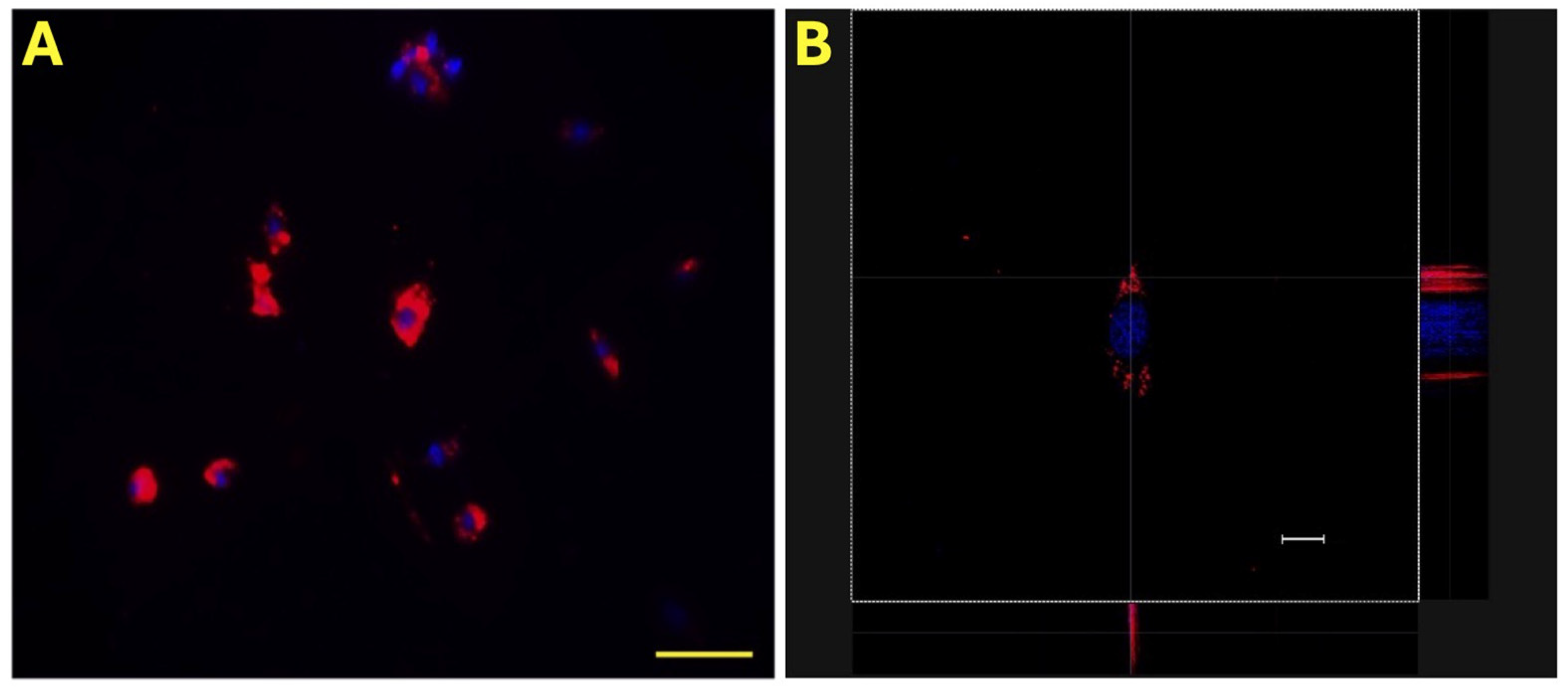
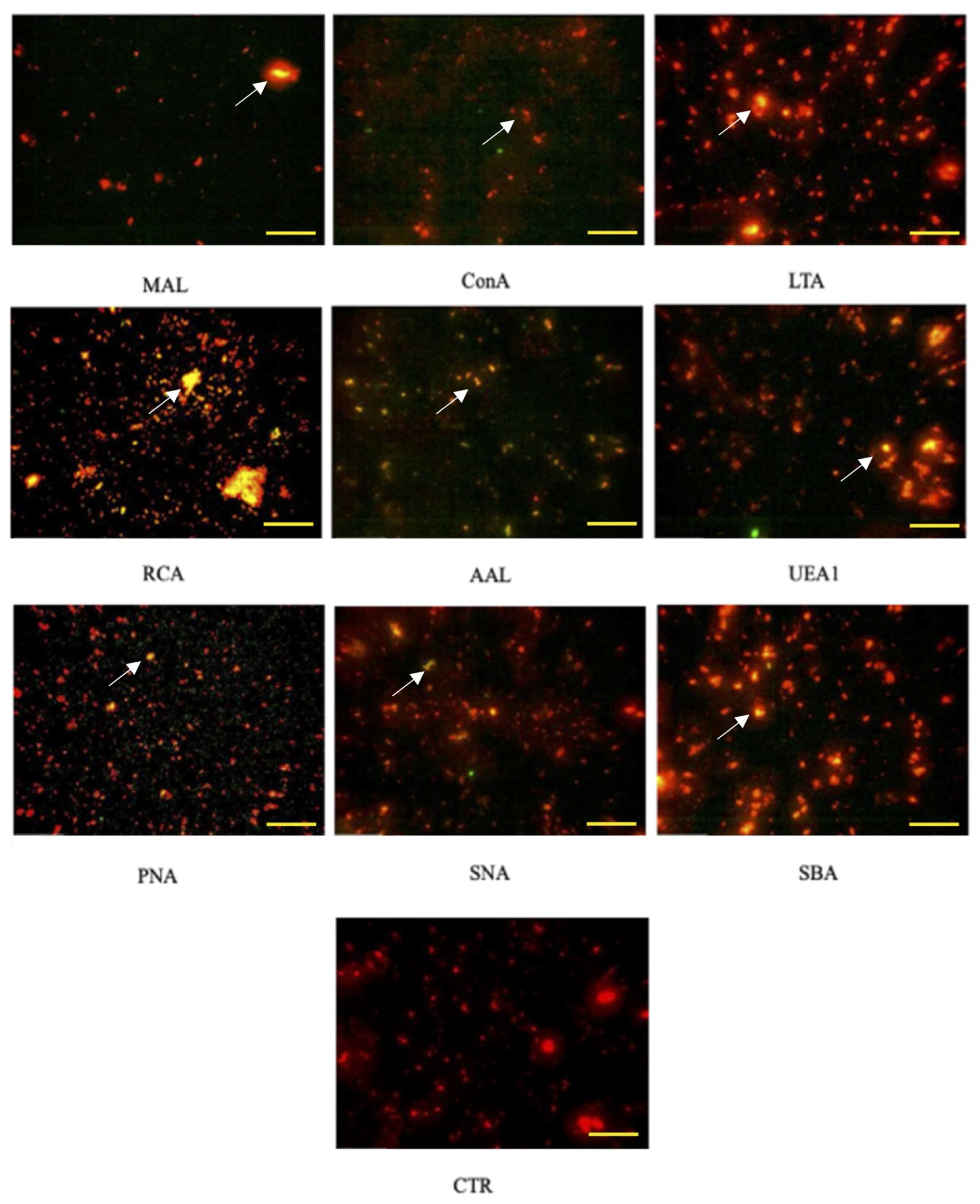

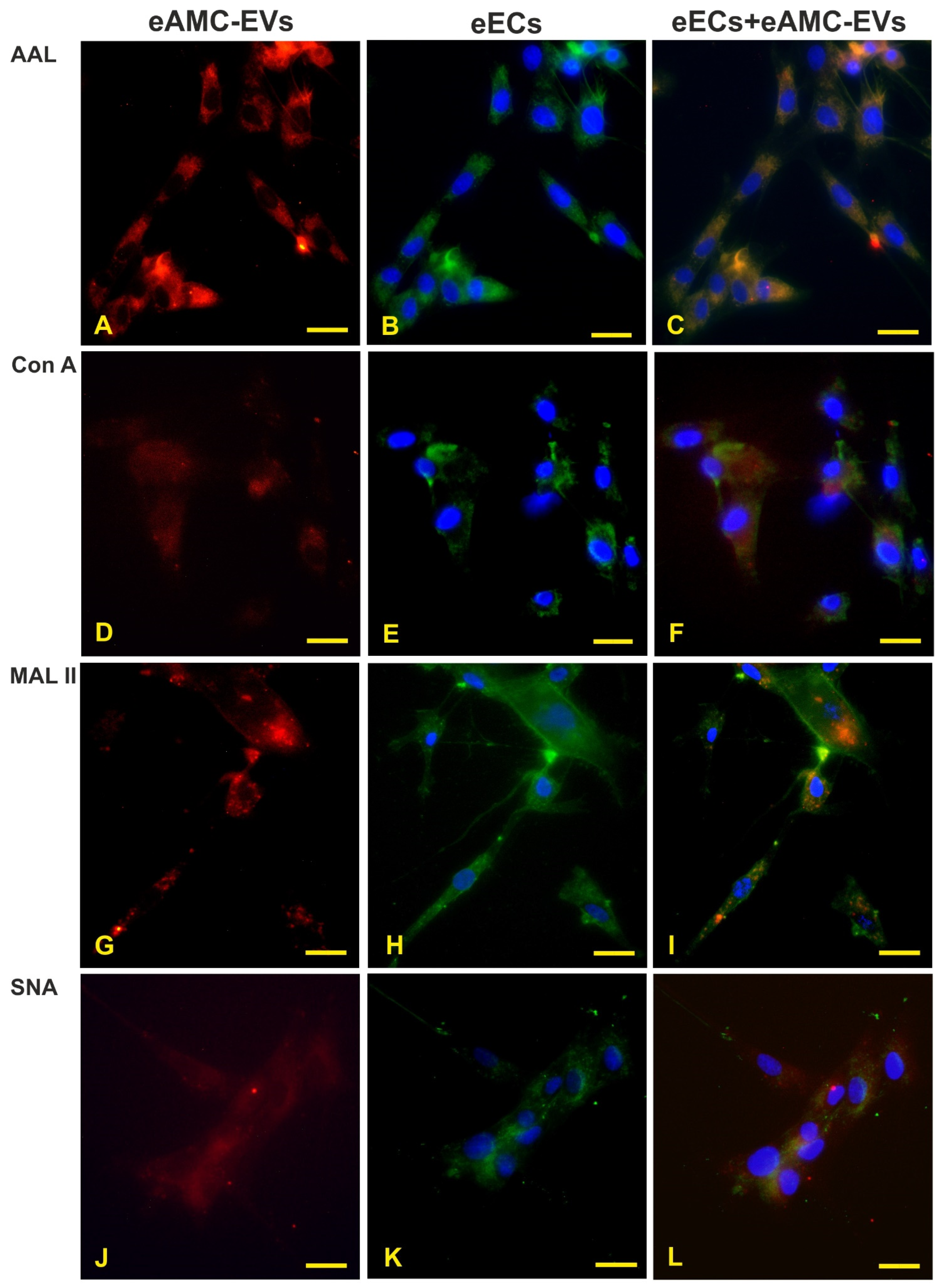
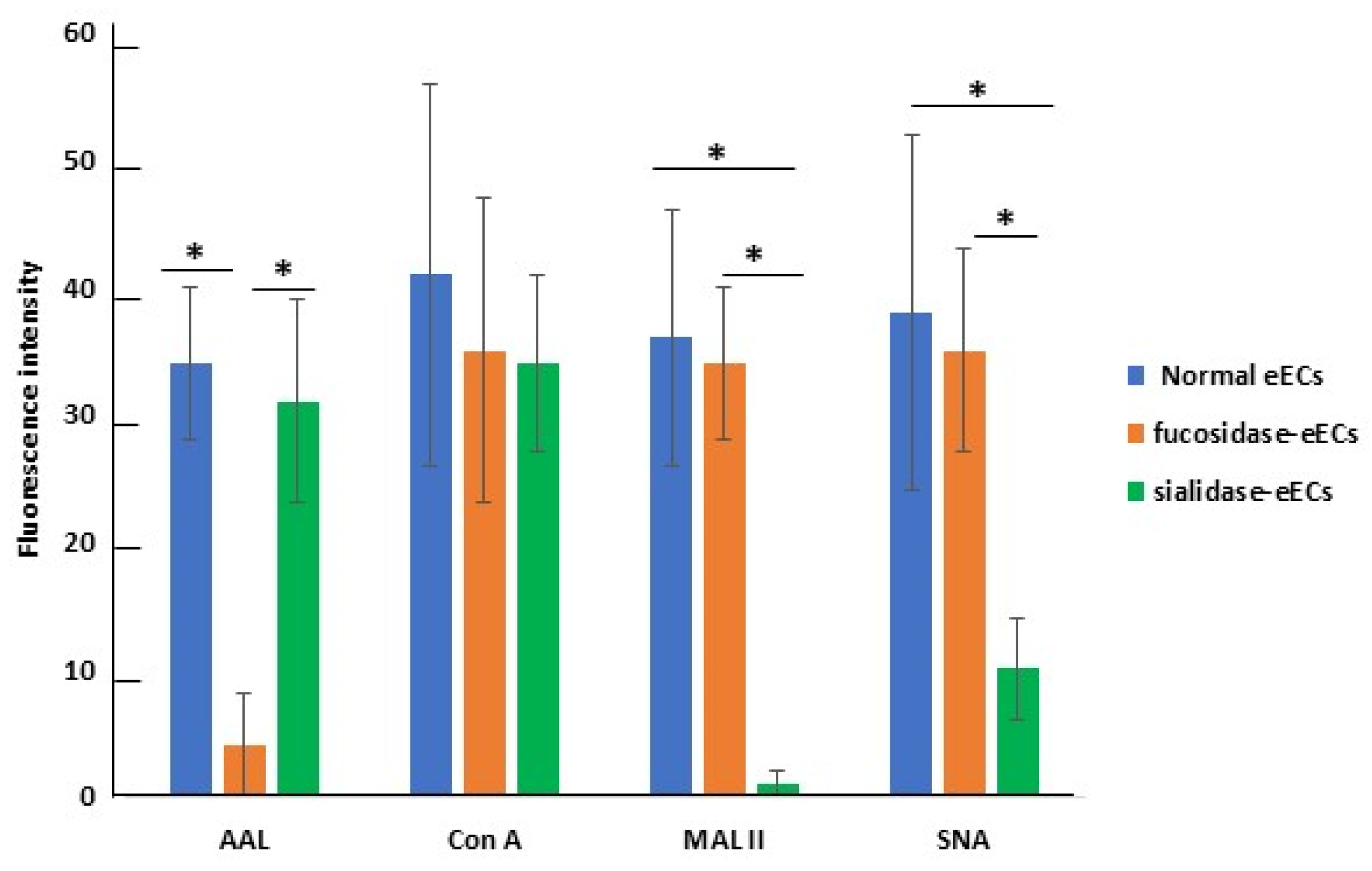



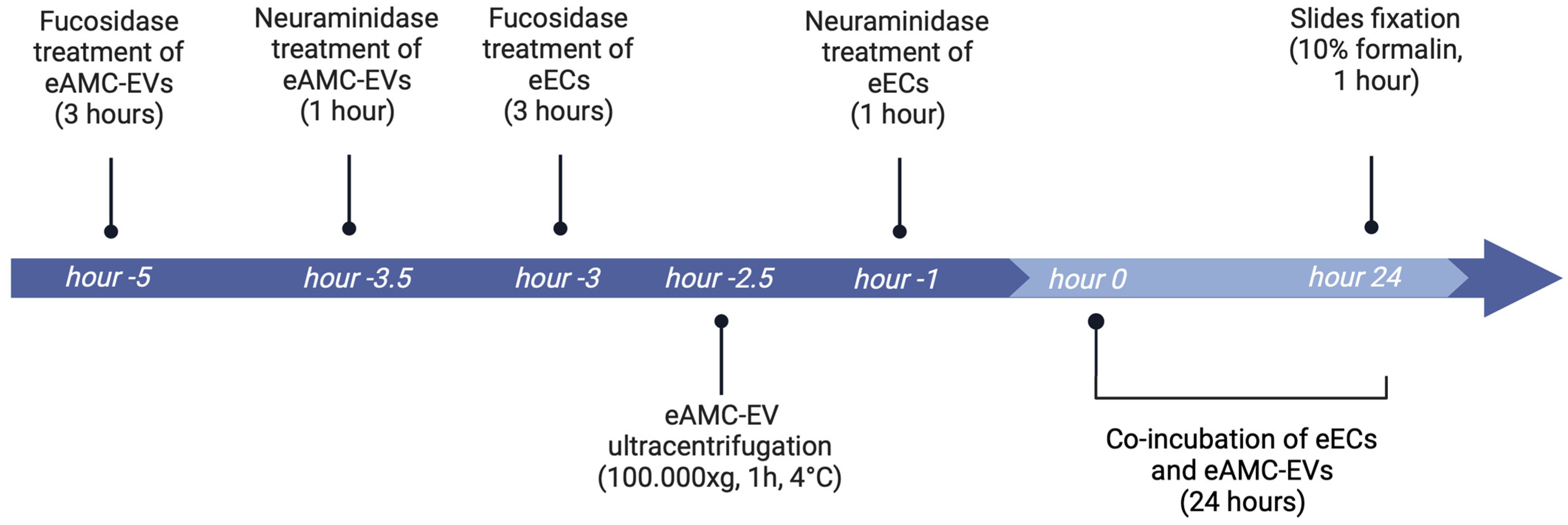
| Lectin Abbreviation | Source of Lectin | Concentration (µg/mL) | Typical Glycan Bound | Inhibitory Sugar |
|---|---|---|---|---|
| AAL | Aleuria aurantia | 50 |  α1-2/1-3/1-4/1-6 α1-2/1-3/1-4/1-6 | Fuc |
| Con A | Canavalia ensiformis | 50 |  | Man |
| LTA | Lotus tetragonolobus | 50 |  | Fuc |
| MAL II | Maackia amurensis | 50 |  | NeuNAc |
| PNA | Arachis hypogaea | 50 |  | Gal |
| RCA120 | Ricinus communis | 50 |  | Gal |
| SBA | Glycine max | 50 |  | GalNAc |
| SNA | Sambucus snigra | 50 |  | NeuNAc |
| UEA I | Ulex europaeus I | 50 |  | Fuc |
 | ||||
Disclaimer/Publisher’s Note: The statements, opinions and data contained in all publications are solely those of the individual author(s) and contributor(s) and not of MDPI and/or the editor(s). MDPI and/or the editor(s) disclaim responsibility for any injury to people or property resulting from any ideas, methods, instructions or products referred to in the content. |
© 2025 by the authors. Licensee MDPI, Basel, Switzerland. This article is an open access article distributed under the terms and conditions of the Creative Commons Attribution (CC BY) license (https://creativecommons.org/licenses/by/4.0/).
Share and Cite
Gaspari, G.; Lange-Consiglio, A.; Cremonesi, F.; Desantis, S. Role of Glycans in Equine Endometrial Cell Uptake of Extracellular Vesicles Derived from Amniotic Mesenchymal Stromal Cells. Int. J. Mol. Sci. 2025, 26, 1784. https://doi.org/10.3390/ijms26041784
Gaspari G, Lange-Consiglio A, Cremonesi F, Desantis S. Role of Glycans in Equine Endometrial Cell Uptake of Extracellular Vesicles Derived from Amniotic Mesenchymal Stromal Cells. International Journal of Molecular Sciences. 2025; 26(4):1784. https://doi.org/10.3390/ijms26041784
Chicago/Turabian StyleGaspari, Giulia, Anna Lange-Consiglio, Fausto Cremonesi, and Salvatore Desantis. 2025. "Role of Glycans in Equine Endometrial Cell Uptake of Extracellular Vesicles Derived from Amniotic Mesenchymal Stromal Cells" International Journal of Molecular Sciences 26, no. 4: 1784. https://doi.org/10.3390/ijms26041784
APA StyleGaspari, G., Lange-Consiglio, A., Cremonesi, F., & Desantis, S. (2025). Role of Glycans in Equine Endometrial Cell Uptake of Extracellular Vesicles Derived from Amniotic Mesenchymal Stromal Cells. International Journal of Molecular Sciences, 26(4), 1784. https://doi.org/10.3390/ijms26041784






